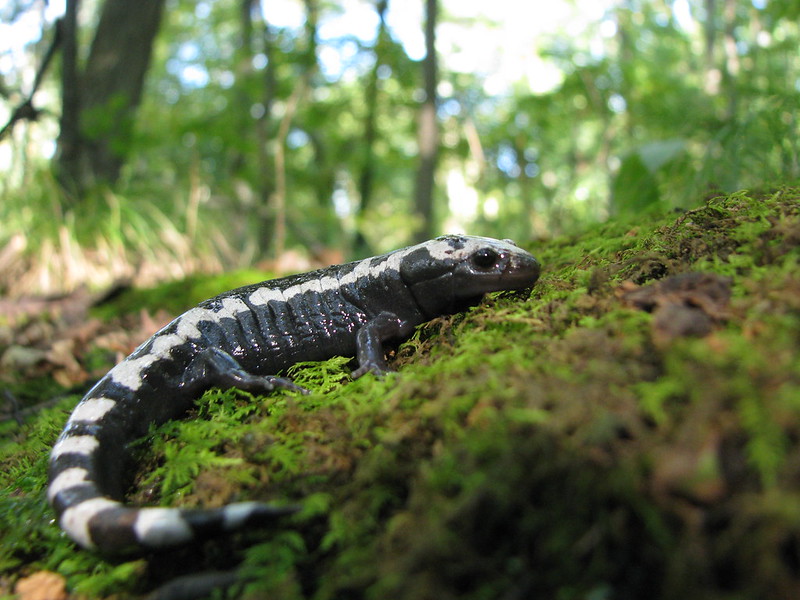When Hurricane Ian brought relentless rainfall to the Chesapeake region, wildlife experts at Jug Bay Wetlands Sanctuary had their minds on salamanders.
With high rainfall totals predicted, citizen scientists at the Patuxent River wetlands preserve predicted the marbled salamander would be on the move, looking for a vernal pool in which to lay their eggs. But their travel could be put to a tragic end as the tiny salamanders tried to cross roads near the sanctuary. So the vernal pool specialists sprang into action.
The marbled salamander has unique reproductive habits. Of the 23 species of salamanders listed by the Maryland Biodiversity Project the marbled salamander is the only terrestrial one with a fall reproductive cycle and it involves a remarkable migration.
Just two to four inches long, this forest-dwelling amphibian hides under logs, in holes, under leaves, or any dark damp area. Moisture is a must because they cannot survive getting dry (known as desiccation). While they are hidden, they eat whatever small morsels they find: insects, worms, etc.
Even though they are fairly common, the salamander’s life cycle makes their survival as a species seem tenuous. Marbled salamanders require vernal pools—slight depressions in the ground that collect standing water in the spring but dry out in the summer. Instead of laying and fertilizing eggs in the spring, they walk long distances in the fall and lay the eggs in what will become a vernal pool in the spring.
Thanks to Hurricane Ian, the first heavy rain of fall was forecast for Sept. 30. Jeanette Kazmierczak, who monitors vernal pools at Jug Bay, predicted that a large marbled salamander migration would occur overnight. A fall rain event would allow the salamanders to travel to the pools without getting dry. Jeanette and her colleagues worried that the salamanders were in danger of being run over. So a group of five vernal pool specialists took flashlights out to the roads and searched for the amphibians on the asphalt to move them out of danger. Most of the moving was just a nudge on the tail to spring them into action but sometimes they needed to be picked up (with very clean hands) and set in the direction of the nearest vernal pool.
Jeanette says their group of five moved around 300 salamanders off the road in just that one night. Usually the migrations occur over several days but a two-week dry period necessitated this mass movement.
Jeanette says that the likely reason for the fall egg laying is because the marbled salamander larva get a head start in front of the spring-spawning spotted salamander and will actually feed on their larva. In the late spring, as the vernal pools dry up, the now-juvenile marbled salamanders will leave the pools and cross through the woods to find a place to live. They become sexually mature at around 18 months old. Once they reach maturity, they will make the fall trek back to their birth spot to reproduce.
Are marbled salamanders at risk from predators during their march to a vernal pool? It turns out that marbled salamanders are mildly poisonous to eat and are generally left alone.
During their vernal pool studies, the Jug Bay monitoring group has found seven different salamander species. They do fall studies on the marbled salamanders and, starting in February, study the pools weekly for the very early spring species. Despite being ectothermic (cold-blooded), spotted salamanders are known to crawl under snow to reach a vernal pool. Being cold is part of the work when doing vernal pool monitoring. Volunteers for vernal pool monitoring are welcome at Jug Bay, but it takes dedication as it’s a nights-and-weekends job.
Vernal pool monitoring takes place from the beginning of February through the end of May and Jug Bay typically holds training sessions. To learn more, call 410-222-8006 or email jugbay@aacounty.org.
-Wayne Bierbaum




